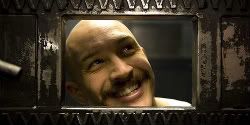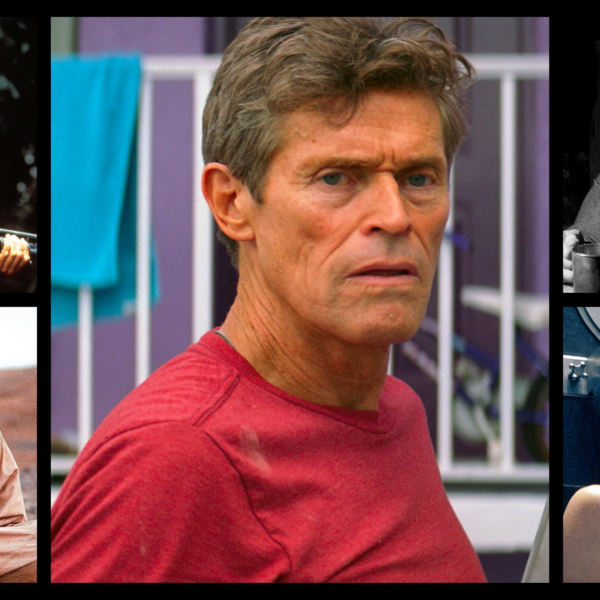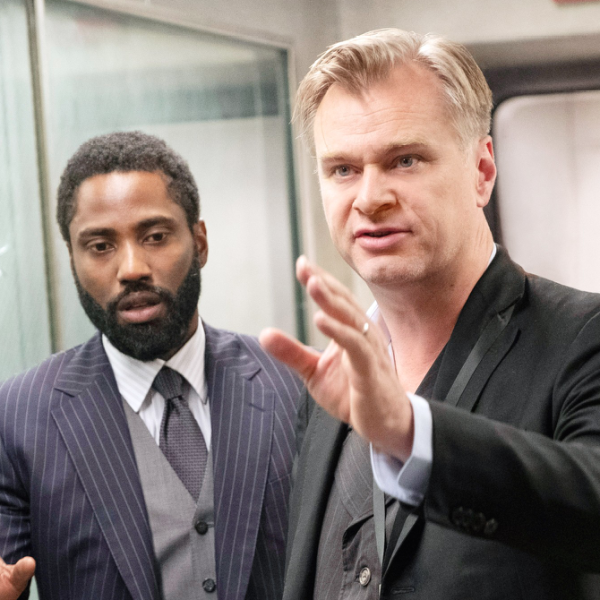
After months of build-up, moviegoers finally got a look at “Drive,” the much-acclaimed crime thriller by Nicolas Winding Refn, this weekend. With a C- Cinemascore (whatever that’s worth), it’s clearly a divisive picture, but there’s been enough passion spent on the film, here and elsewhere, to suggest that plenty of discerning cinephiles have fallen for it in the way that several Playlist staffers have in recent weeks. And if you were one of them, Refn might have been a new face for you; the director has been active for fifteen years now, but only really started to come to attention of U.S. film fans in the last few years (or arguably, months), thanks to a pair of English-language pictures.
With that in mind, we’ve delved into the director’s repertoire to take a look at the predecessors to “Drive,” and to pinpoint a few good starting points for anyone who wants to see more from the eccentric, uncompromising Danish helmer. It would be too easy, but not entirely inaccurate, to classify Refn as a genre deconstructionist in the vein of Quentin Tarantino. They share a similar anti-authoritarian view of the world, an eye for brutal and beautiful violence, and the director is every bit the passionate student of cinema and true movie geek that the “Inglourious Basterds” helmer is famous for being. As Refn put it during a recent interview on The Sound of Young America, “violence is part of the catharsis. [The characters] have to go through extreme pain and suffering in order to obtain what they’re meant to be.” But while Tarantino is almost Americana incarnate (albeit with lashings of French New Wave and spaghetti western incorporated into the mix), Refn is a firmly European filmmaker, even when making a pulpy L.A. genre movie like “Drive.”
Refn (who is colorblind, trivia fans, and can’t see mid colors, hence the high level of contrast in all his works) was pretty much born into the business, his mother a successful photographer, his father himself a director and editor in the Danish film industry (he cut Lars von Trier‘s “Breaking the Waves” and “Antichrist“). And the fledgling director’s first film, “Pusher,” saw him become identified with a wave of European movies in the mid-1990s that proved deeply influential, featuring the gritty style, social realism and lack of romanticization that characterises many subsequent admired crime movies, like “City of God,” “Gomorrah” and “A Prophet.” However his career hit some speed bumps with his sophomore effort “Bleeder” in 1999 and its follow-up four years later, “Fear X,” starring John Turturro, which was his first film shot in English: the films both flopped, leading him to scrap his next planned project, “Billy’s People.” Instead, he headed back to the world of “Pusher,” in the form of two sequels he wrote and directed in the span of two years. This worked out well, as portrayed in the excellent 2006 documentary “Gambler” (available as a special feature on the Pusher Trilogy DVD set), and is a rare example of a filmmaker making two sequels, unashamedly for the money, and yet the films paying off creatively as well as financially. With his debts settled and a new-found artistic philosophy in place, Refn moved on to the next stage in his career, with “Bronson,” “Valhalla Rising” and now “Drive,” the latest of which won him Best Director at Cannes. If you liked “Drive” this weekend, read on for more on those earlier pictures, all of which (bar his made-for-TV “Marple“) should be available on DVD.
 “Pusher” (1996)
“Pusher” (1996)
If Nicolas Winding Refn set out to make a name for himself with his first film, “Pusher,” he succeeded. Following a low-life drug peddler, Frank (Kim Bodnia), over the course of a week, things go from bad to worse. Frank is probably the worst and most unlucky drug dealer in Copenhagen. When he and his partner, Tonny (Mads Mikkelsen), aren’t trying to sell drugs, they’re either aimlessly partying or just wasting time until something happens. After a drug deal goes bad, Frank has to face his friend, Milo (Zlatko Buric), the local drug lord, without the drugs or the money. Refn’s bare bones approach and sparsely populated world reflects the complete lack of glamor that comes with this lifestyle and the loneliness that is inherent in it. Building the anticipation throughout the first half of the film, Refn constantly hints that violence is right around the corner, but resists revealing it. When the violence finally explodes, it is fast, brutal and relentless. As a filmmaker, Refn never interferes with the characters but is always firmly situated right in the middle of the action. The first installment in what would become Refn’s “Pusher” trilogy, the film is a terrific example of the director’s talent and his affinity for anti-heroes, nihilism and unrestrained aggression. [A-]
 “Bleeder” (1999)
“Bleeder” (1999)
In many ways, “Bleeder” feels more like a first film than “Pusher.” Where Refn’s debut displayed a confidence in its style and narrative with a firm grasp of tone, “Bleeder” is rather arrogant and show-offy in those departments (take, for example, a shot early in the film where the camera flies all over a video store as it glides by shelves upon shelves of VHS tapes). It feels a bit all over the place, and at times unwieldy, like the filmmaker had a lot of ideas he was wrestling with and didn’t know how to completely tie them together. But upon subsequent viewings, and perhaps with the benefit of hindsight, those issues become more charming, the product of an overzealous director willing to go places most won’t dare resulting in some radical, WTF tonal and genre shifts. This is basically Refn’s take on the slacker comedy, or to be more precise, this is his “Clerks” mixed with “High Fidelity” with a dash of “Eraserhead” and a crazy violent streak that seems directly pulled from the ‘Pusher Trilogy‘. In fact, the violence is the film’s biggest issue. The scenes involving guns come off as forced, awkward and false (things we’d rarely accuse Refn of), not unlike the scene in “Swingers” when Sue draws a gun on the House of Pain wannabes. But the flaws are outweighed by a pure passion for cinema and a self-awareness that what you’re watching is in fact a falsity, something we missed the first time out. Refn reunited his three male actors from “Pusher” for the film’s dual narratives: one is very charming and cute, about a movie-obsessed social misfit (played with aplomb by Mads Mikkelsen) working at a video store and trying to connect with a pretty blond he meets; the other is raw and brutal, about a man (Kim Bodnia) trying to deal with the fact that he’s about to become a father, and the manifestation of his fear of growing up. The former storyline is the most appealing, and makes up for some of the latter’s more outlandish and extreme moments. Ultimately, “Bleeder” is a tough film to grasp, but if you approach it on its own terms, it reveals itself to be a mostly successful piece of self-reflexivity, one that exists in a dreamy/nightmarish (un)reality that Refn would explore further in “Fear X” and “Valhalla Rising.” [B]
 “Fear X” (2003)
“Fear X” (2003)
What starts out as a fairly standard-issue thriller quickly gives way to the kind of unquantifiable psychic weirdness we’ve come to expect from Mr. Refn. Based on an original screenplay by “Requiem for a Dream” author Hubert Selby Jr., “Fear X” stars John Turturro as a security guard whose wife was recently murdered at the mall where he works. He’s been obsessively trying to piece together the details surrounding her death, with a wall of his house devoted to possible suspects – people he’s seen on surveillance footage and attempted to identify. When he finally gets a break in his investigation (aided, in no small part, by a mystical vision of his wife’s ghost), things turn truly bizarre, leading to an ending that no one (including Turturro and Refn) can adequately explain. In the second half of the movie, when the perspective is split between Turturro and James Remar, as the sympathetic murderer (who appears to be involved in some kind of shadowy, corporately funded group that systematically murders dirty cops), the oppressively claustrophobic atmosphere of the first part of the film is lifted; it dissipates into a low-lying mist. What remains is still quite spooky, of course, full of characteristic Refn flourishes (he often pushes the camera into the back of Turturro’s head to reveal a small demonic figure pushing against his brain) and featuring a dread-inducing minimalist electronic score by Brian Eno. Sometimes frustratingly tough to pin down, “Fear X” was such a commercial failure that it forced Refn to shutter his production company. A shame, really, for such an interesting movie, anchored by one of Turturro’s finest performances. [B-]
 “With Blood on My Hands: Pusher II” (2004)
“With Blood on My Hands: Pusher II” (2004)
The middle chapter in “The Pusher Trilogy” follows its most pathetic character. Yet it’s the strongest film of the series, and the darkest in tone and consequences. It’s Mads Mikkelsen‘s impeccable performance that gives this entry the higher grade. He’s back as Tonny, the wannabe big-timer junkie and all-around social misfit with RESPECT tattooed on the back of his shaved head (one of the film’s many funny, then eventually sad, ironies; Tonny takes more shit than a construction-site outhouse in these films). Last time we saw him in the first film, he was taking the beating of a lifetime from ex-buddy and partner Frank (Kim Bodnia). In ‘With Blood on My Hands‘, we pick up with him leaving prison and attempting to get back in the game. He goes to his father’s shop, hoping to get a job. But pops ain’t too keen on having Tonny around. Soon it’s revealed that a bastard child is most likely his, and things spiral down from there. On the surface the ‘Pusher’ films are all about mounting anxiety in a short period of time, and with it the building of at times unbearable tension, of which Refn is clearly already a master. The birth of the director’s first child no doubt played a big part in shaping the narrative and themes of this middle chapter, as well as his debts from the failure of “Fear X.” ‘Pusher 2′ is a great example of a personal film, stamped with the director’s DNA and life experiences, that never overwhelms the focus of the characters’ journeys. It doesn’t matter if you know about Refn’s history or not, the film works without that knowledge. But with it, it achieves another level of depth and interest. And again, we have to give it up to Mikkelsen, a fantastic performer (unlike Tonny, who has one of the most embarrassing sex scenes ever put on film) with an intensely-squared jawline that only adds to the intensity and pain in his eyes. Here’s hoping Refn hasn’t given up on working with Mads again while he’s working with Ryan Gosling for the foreseeable future. [A]
 “I’m the Angel of Death: Pusher III” (2005)
“I’m the Angel of Death: Pusher III” (2005)
“I’m not a crime buff in any way, but I am interested in people, the sociological aspect. With gangsters, it’s life or death which intensifies the drama.” Refn says in the documentary “Gambler,” and while that’s hard to believe, it’s actually the secret to the “Pusher” films. He’s not interested in checking off the same tropes that many filmmakers employ in this genre. And partially because of that, he’s made a trilogy in which each chapter works as a satisfying standalone picture while also adding to the greater whole. In the final entry in the series, Refn focuses on Milo (Zlatko Buric), the drug lord who is the only character to shows up in all three films. ‘I’m the Angel of Death’ is basically a feature-length version of the famous coke-and-helicopters sequence in “Goodfellas.” And if your palms are getting sweaty with anxiety just thinking about that notion, then the film may be too intense for some. Those willing to stick with it to the brutal, gory end (though the filmmaker shows a knack for the subliminal here, no doubt gleaned from his on-the-record appreciation of ‘Texas Chainsaw Massacre‘; the viewer thinks they see more than they actually do) are in for a treat, with a climax that ends on a pitch perfect image. The film takes place over a 24-hour period as Milo prepares a birthday party for his daughter (she’s turning 25, but gives new meaning to the term princess complex; she makes Veruca Salt from ‘Willy Wonka‘ look like a father’s dream by comparison), as he also tries to stay clean (he attends several narcotics anonymous meetings) and navigate the ever-changing drug business around him. Every time things begin to get too bleak in the film, Refn pauses the insanity and gives us real reasons to empathize with Milo. We may understand him, but Refn never lets his main character off the hook. It’s, sadly, too late for Milo. The fact that we care is the film’s most impressive feat. [A-]
 “Miss Marple: Nemesis” (2007)
“Miss Marple: Nemesis” (2007)
The pay must’ve been good for this for-hire Agatha Christie ITV adaptation, as this episode of the latter aughts’ Marple series has about zero of the Danish’s directorial flourishes and visual creativity. The titular character (played by Geraldine McEwan, “Robin Hood: Prince of Thieves“) receives a letter by a wealthy man she met once, stating that she is to solve a crime in order to receive the money he left her in his will. However, he’s coy about the crime, and instead sets her up on a tour of certain spots in Great Britain and is otherwise left to her own devices. Slowly she uncovers a story about a nun named Verity who had rescued a crashed German pilot and nursed him back to health with her fellow sisters. As the plot thickens and bodies start dropping, Marple must figure out who is responsible for the murders and disappearance of Verity before it is too late. It’s a serviceable mystery in a way that a TV movie would be, but it mostly lacks that certain aggressive intrigue that some of the best entries of its genre have. That might have something to do with the fact that it’s kind of dull at first and hard to follow, but once the audience eventually gets to know the characters well enough to be suspicious of everyone things click properly into place and some fun participation is had. Still, Refn plays it straight save for a few moments (an expository dining scene, in which everyone interjects and relays information, is made playful/amusing by placing everyone at small two-seating tables rather than a lavish, typical grand table), proving that he can be faceless if the project calls for something no-frills. Not necessarily for the man’s completists; Christie fans could probably care less for the filmmaker’s pedigree. [C]
 “Bronson” (2008)
“Bronson” (2008)
At some point Michael Gordon Peterson (played by a magnetic, frequently nude Tom Hardy), notoriously known as the most violent and expensive (due to his part in a massive prison riot) prisoner in the history of the English penal system, decided to adopt his “fighting name” of Charles Bronson, after the American action film star; the movie about his life is similarly assaultive. This is Refn at his most operatically full-tilt, unerringly violent, gorgeously photographed, laugh-out-loud funny and embroidered with animation, slow motion that’s so slow it borders on still photography, and an attempted murder sequence scored to the Pet Shop Boys‘ giddy “It’s a Sin.” At a crackling 92 minutes, the film whizzes by, mostly on the bravado performance by Hardy, exceptional on every level, and the equally bravado direction by Refn. In England, where the movie was first released, the critics were both more up in arms at the film’s content and more enthusiastic about the final product (one critic, quoted on the poster, called it this generation’s “A Clockwork Orange“). When the film finally came to America, it had a small theatrical release and most reviewers simply shrugged, unsure of what to make of its muscular strangeness. This reception will probably be revised, as the film is discovered by a wider audience for being the movie that launched Tom Hardy’s career as though out of a cannon, and marked the opening salvo in a new, higher-profile phase of Refn’s. It seems destined for cult appreciation. [A-]
 “Valhalla Rising” (2009)
“Valhalla Rising” (2009)
Not so much dividing critics as cleaving them in two with a gore-edged axe, “Valhalla Rising” is probably the least approachable Refn film to date. The story is of a mute one-eyed warrior who escapes captivity, falls in with a crew of would-be crusaders and embarks on a doomed voyage to the Holy Lands with them, forming an unlikely alliance with a young boy along the way. And while that synopsis could lend itself to a thigh-slapping, epic swashbuckler with Hollywood-style daddy issues (“Braveheart” meets “The Champ“!) don’t be fooled: this is a glacially paced, sporadically violent arthouse picture for which even the most patient viewer needs to be in the right mood, or drying paint might seem an attractive viewing alternative. If you can go with it, however, the film’s contemplative pleasures are manifold: the controlled, slow-developing, sometimes brutal images can evoke Tarkovsky and Bergman, while themes and nuances bring to mind Malick and Herzog. Lofty comparisons indeed, but they are fleeting: as soon as such a parallel occurs to the viewer, it is contradicted: violence here is usually between men, not men and nature, and despite some characters’ religiosity the film seems deliberately void of philosophical tendencies, featuring few symbols or metaphors — things are what they are, then someone gets an axe in the throat. So flattering comparisons aside, really just two things save this microscopically budgeted, willfully obscure endeavor from descending to pretentious student film level: firstly Refn’s absolute, rock-solid directorial conviction. His almost totalitarian grip on the tone and intention of the film never wavers: love it or hate it, you can be in no doubt this is the movie he meant to make. The second is Mads Mikkelsen — buried under thick, disfiguring make up (what is up with the eye scarring? This and “Casino Royale,” and doesn’t he wear an eye patch in ‘Three Musketeers‘?) and without a single word of dialogue, he still radiates sheer bad-ass intensity and charisma. A rip-roaring thrill ride it is not, but if you fancy spending 90 minutes in a strange state of suspended animation within a nihilistic limbo (and, occasionally, who doesn’t?), ‘Valhalla’ awaits. [B]
–Christopher Bell, Kimber Myers, Drew Taylor, Jessica Kiang, Matthew Newlin, Erik McClanahan







